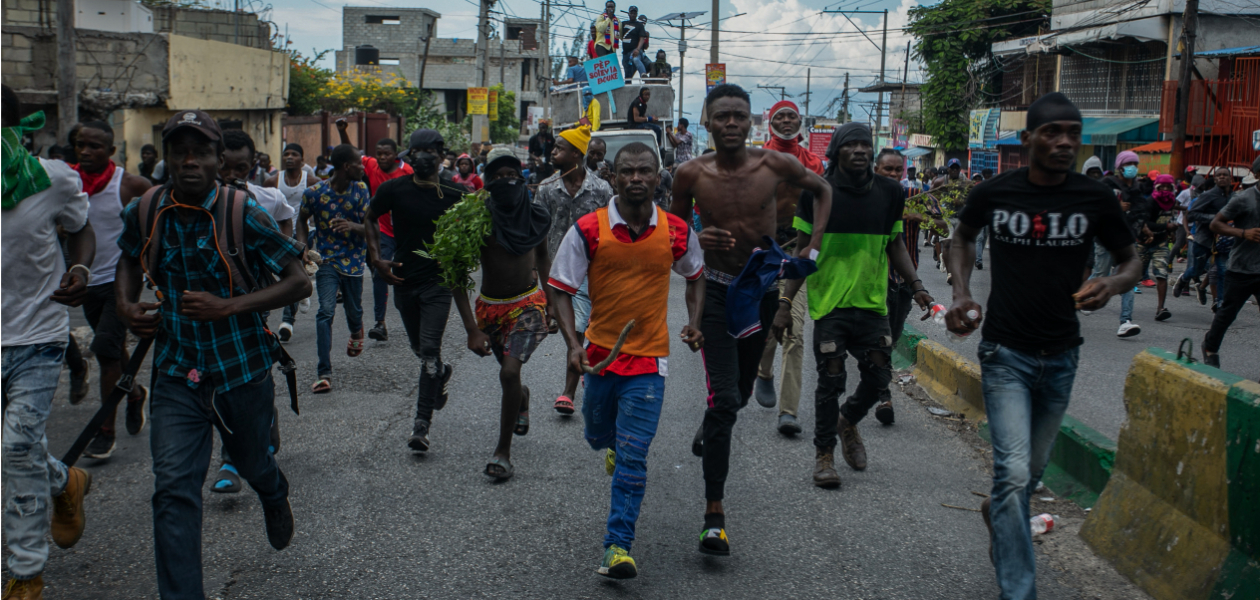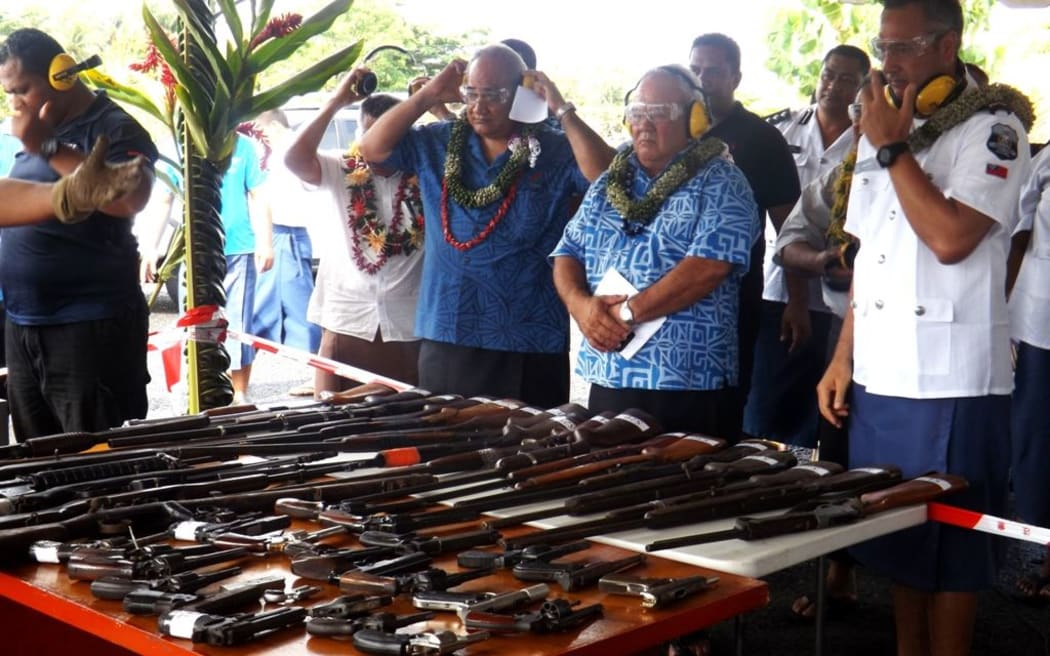How The United States “Very Lightly Regulated Gun Laws” And “Exports” Have Helped Create “Criminal Economies”; Ongoing Deadly Gang Violence In Haiti And Firearm-Fueled Violence in Central America
The world today is tainted by the pervasive influence of violence, fueled by a steady influx of weapons, many of which originate from the United States. This concerning trend, whether through legal exports or illicit trafficking, has far-reaching consequences, worsening conflicts and destabilizing regions across the world. One such example is Haiti, where the unchecked flow of firearms has contributed to "criminal economies", escalating gang violence and political turmoil. In contrast, in Central America, legal exports are creating firearm-fueled violence, prompting urgent calls for intervention and tighter controls on arms from the United States.

The ease with which violence is erupting in various parts of the world is found to be greatly facilitated by a consistent influx of weaponry sourced from none other than the United States, whether through exports or illicit trafficking.
According to data from the United States International Trade Commission, March 2022 saw the highest export of semi-automatic firearms from the U.S. to El Salvador since March 2018.
Between 2010 and 2020, the export of U.S. semi-automatic firearms globally surged, with figures quadrupling from approximately 100,000 pistols and 9,000 rifles to around 404,000 pistols and 23,500 rifles.
Notably, in 2022, exports of semi-automatic rifles, including assault weapons like the AR-15, reached their peak since the federal government started specifically reporting on such exports in 2005.

United States Facilitating’ Criminal Economies’
Haiti’s Criminal Economy has long been plagued by armed groups, worsening unrest and prompting calls from human rights advocates to stem the flow of illicit firearms, particularly from the United States.
As Port-au-Prince wrestles with a surge in deadly gang attacks, voices are once again demanding action to halt the influx of weapons.
Rosy Auguste Ducena, a lawyer and program director at the National Human Rights Defense Network, stresses that Haiti lacks domestic arms manufacturing, pointing to the significant inflow of weapons, predominantly from the United States, as a major source of the country’s suffering.
The unchecked influx of firearms, ranging from handguns to military-grade weaponry, has deepened Haiti’s woes, compounded by weak governance, corruption, and challenges in monitoring the extensive coastline.
Hence, many advocate tighter controls on outbound arms shipments from the United States as a crucial step toward mitigating Haiti’s crisis.
Compounding Problems
Haiti’s political instability, aggravated by foreign interference and internal corruption, intensified following the assassination of President Jovenel Moise in July 2021.
The resulting power vacuum has bolstered the influence of armed gangs, which now wield significant control over Port-au-Prince, making political demands and escalating violence with increasingly sophisticated weaponry.
Funding for weapons and gang activities largely stems from illicit sources such as drug trafficking, kidnapping, and extortion.
In 2023 alone, Haiti witnessed over 2,490 kidnappings and a staggering 119.4 percent increase in homicides compared to the previous year.
In late January, Ghada Waly, head of the U.N. Office on Drugs and Crime, issued a warning to the U.N. Security Council regarding the proliferation of weapons in Haiti, highlighting the urgent need for intervention.
More than 360,000 individuals currently find themselves displaced due to ongoing violence, with the World Food Programme sounding the alarm on Haiti’s descent into a humanitarian crisis and the looming threat of famine.

The Steady Flow Of Firearms
The types of firearms being trafficked into Haiti remain a subject of inquiry, with precise figures elusive.
However, a 2023 UNODC report, drawing from Haiti’s National Commission on Disarmament, Demobilization, and Reintegration, suggests an estimated count of up to 500,000 legal and illegal weapons within the country as of 2020.
Robert Muggah, the author of the U.N. report and co-founder of the Igarape Institute, spotlights the predominant origin of these trafficked firearms, indicating that a significant majority likely originate from the United States.
Muggah underscores that over 80 percent of firearms seized in Haiti and submitted for tracing to the U.S. Bureau of Alcohol, Tobacco, Firearms and Explosives (ATF) between 2020 and 2022 were either manufactured or imported from the United States.
According to Muggah’s insights, more than half comprised handguns, with approximately 37 percent consisting of rifles.
The trafficking of rifles into Haiti has notably surpassed similar movements to neighboring Caribbean nations, as pointed out by Matt Schroeder, a senior researcher at the Small Arms Survey research group.
This includes the influx of semi-automatic rifles, such as the popular AR-15s and AK-47s, which are capable of utilizing high-capacity magazines, highlighting their prevalence in recent arms transfers to Haiti.
Furthermore, Schroeder draws attention to the seizure of at least two .50-caliber rifles, akin to those utilized by military snipers, en route to Haiti.
While the exact quantity of such rifles present in the country remains uncertain, Schroeder flags these seizures as significant indicators of concern due to their formidable capabilities in long-distance engagements, including targeting vehicles.

The Illegal Trafficking
Typically, firearms destined for Haiti from the United States are acquired through intermediaries known as “straw men,” who purchase guns from licensed dealers while concealing the ultimate recipient’s identity.
Muggah notes a preference among these purchasers for states in the U.S. with relatively lax gun regulations, including Arizona, California, Georgia, Texas, and Florida.
The choice of Florida as a prime source state for these firearms is notable not only for its major ports but also for its significant cultural ties to Haiti. Situated approximately 1,100 kilometers (683 miles) from Port-au-Prince, the Miami area hosts the largest Haitian diaspora community in the United States.
The “King”
A recent legal case involving Joly Germine, who identifies himself as the “king” of Haiti’s formidable 400 Mawozo gang, sheds light on the mechanisms of weapons trafficking into the country.
As per the U.S. Department of Justice, Germine instructed gang affiliates to transfer funds to collaborators in Florida for the purchase of firearms.
These associates procured a minimum of 24 firearms, encompassing AK-47s, AR-15s, and a .50-caliber rifle, from Florida gun stores, falsely representing themselves as the legitimate buyers. Subsequently, these weapons were camouflaged as food and household items and clandestinely transported into Haiti via shipping containers.
Germine confessed his involvement in the scheme in February and awaits sentencing, while a co-conspirator, who pleaded guilty the previous year, received a 60-month prison sentence on February 28.
The 400 Mawozo gang, led by Germine, has been implicated in violent abductions, including the highly publicized 2021 kidnapping of numerous U.S. and Canadian missionaries, wherein gang members issued a ransom demand through a video, threatening the missionaries’ lives otherwise.
Brian Concannon, the executive director of the US-based Institute for Justice and Democracy in Haiti, identifies the proliferation of firearms in the U.S. as a root concern.

He notes that the U.S. firearm possession surpasses 393 million as of 2017, equating to nearly one firearm per 100 individuals worldwide and constituting almost 40 percent of the global civilian arsenal.
However, Concannon acknowledges recent efforts by the U.S. government to curb weapons trafficking to Haiti, redirecting some traffic to the Dominican Republic.
President Joe Biden‘s administration has implemented new measures to combat the issue, including heightened penalties for straw-man purchases and smuggling, alongside sanctions on Haitian officials accused of aiding gangs.
Moreover, a coordinator for prosecuting firearms trafficking in the Caribbean, including Haiti, has been appointed, with plans for the establishment of a transnational criminal investigative unit in Haiti by the U.S. State Department and Department of Homeland Security.
Furthermore, a U.N. sanctions and arms embargo mechanism targets individuals posing threats to Haiti’s peace and stability, exemplified by the inclusion of Jimmy “Barbecue” Cherizier, leader of Haiti’s G9 gang coalition, under this measure.
Nevertheless, according to Muggah, the persistent high demand for firearms and ammunition ensures their continued trafficking from the U.S. to neighboring nations like Haiti.
A 2023 UNODC report reveals a stark contrast in firearm prices between the U.S. and Haiti, where handguns, for instance, fetch up to $10,000 depending on demand, despite costing significantly less in the U.S.
Furthermore, a former Haitian official suggested the involvement of influential figures in society in weapons trafficking during a discussion with the International Crisis Group (ICG), underscoring the pervasive nature of complicity.
Schroeder stresses the importance of preventing the diversion of legally exported weapons to Haitian gangs and emphasizes the necessity of reducing violence in Haiti to create a conducive environment for strengthening control mechanisms.
She warns of a looming catastrophe, describing Haiti as teetering on the brink of collapse, with its population pushed to the limits of endurance.
Central America’s Legal Battle
In Central America, firearms proliferation is facilitated by various means, with a notable route being the production or importation of guns from the United States and their subsequent sale to buyers in the region.
Once in Central America, these firearms may remain with the original purchaser or be diverted to the illicit market through various means, including commercial sales, theft, or misuse by official security forces, leading to human rights violations.
According to the Government Accountability Office (GAO), a significant portion of firearms recovered from crime scenes in Guatemala and Central America originate from authorized exports from the United States.
Additionally, a substantial proportion of firearms traced from crimes in Mexico are linked to the United States, with many having crossed the border legally.
Expert John Lindsay-Poland from the nonprofit Stop U.S. Arms to Mexico criticizes the Biden administration’s approach to this issue, labeling it as “dangerous.”
However, the current U.S. strategy in the region does not prioritize reducing the influx of weapons.

Despite the Biden administration’s pledge to address the root causes of migration in Central America, there is scant mention of gun violence or the steady supply of firearms that contribute to extortion and violence.
Instead, the focus remains on increasing law enforcement capacity to tackle transnational and national threats, a strategy that aligns with the profit motives of gun manufacturers rather than addressing the root issue.
The lack of action on firearms exports by the United States has aggravated violence in the region, leading to devastating consequences such as the displacement of families and forcing many to undertake perilous journeys in search of safety.







